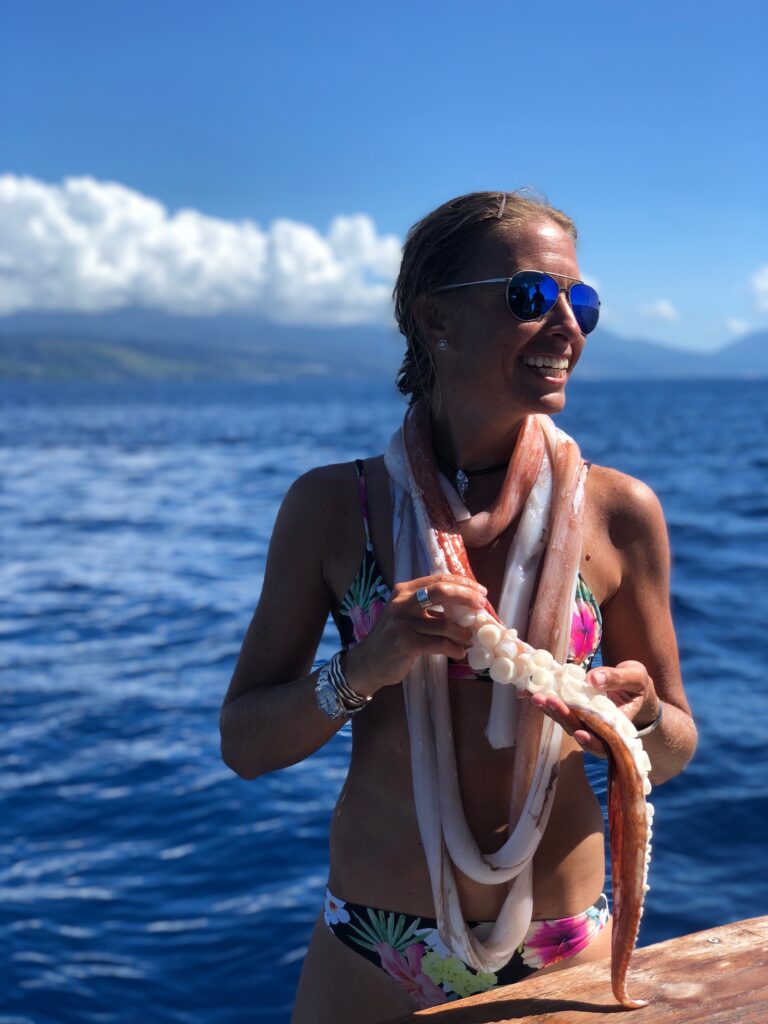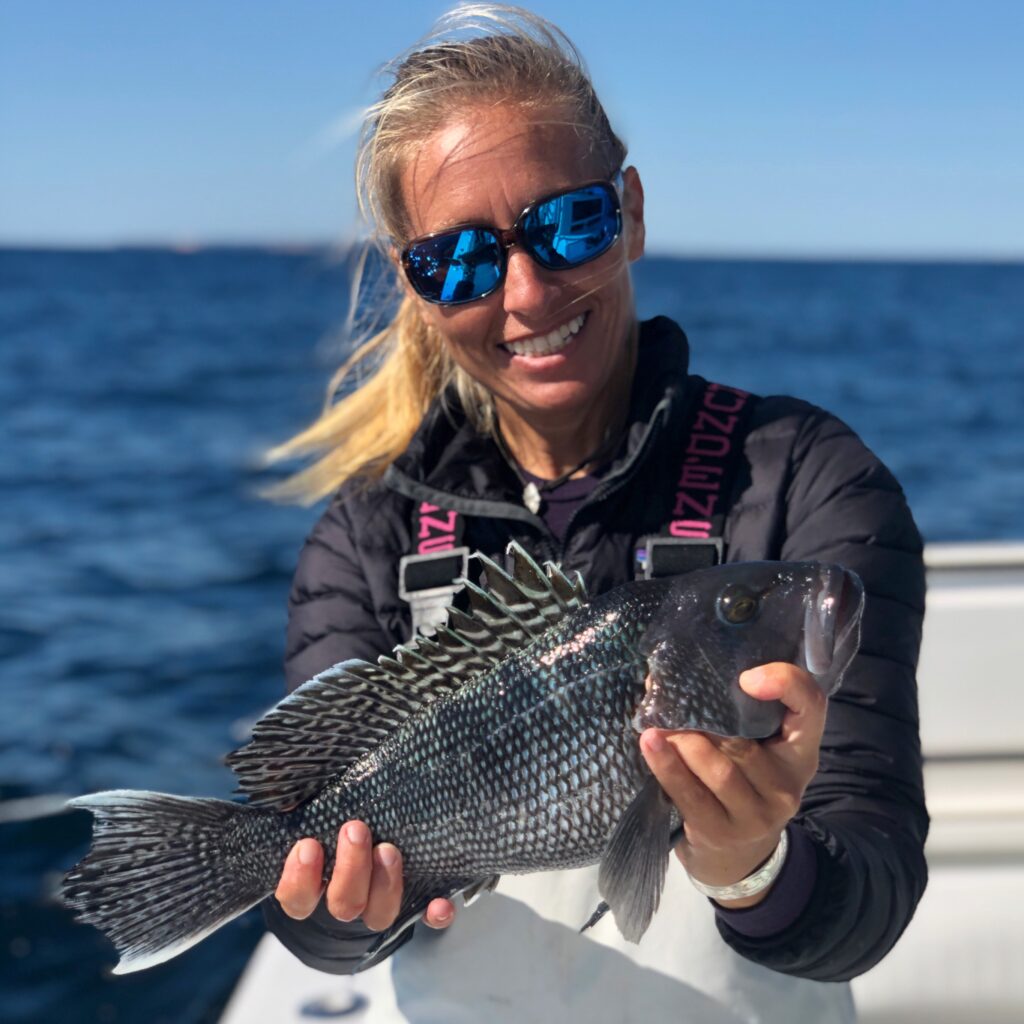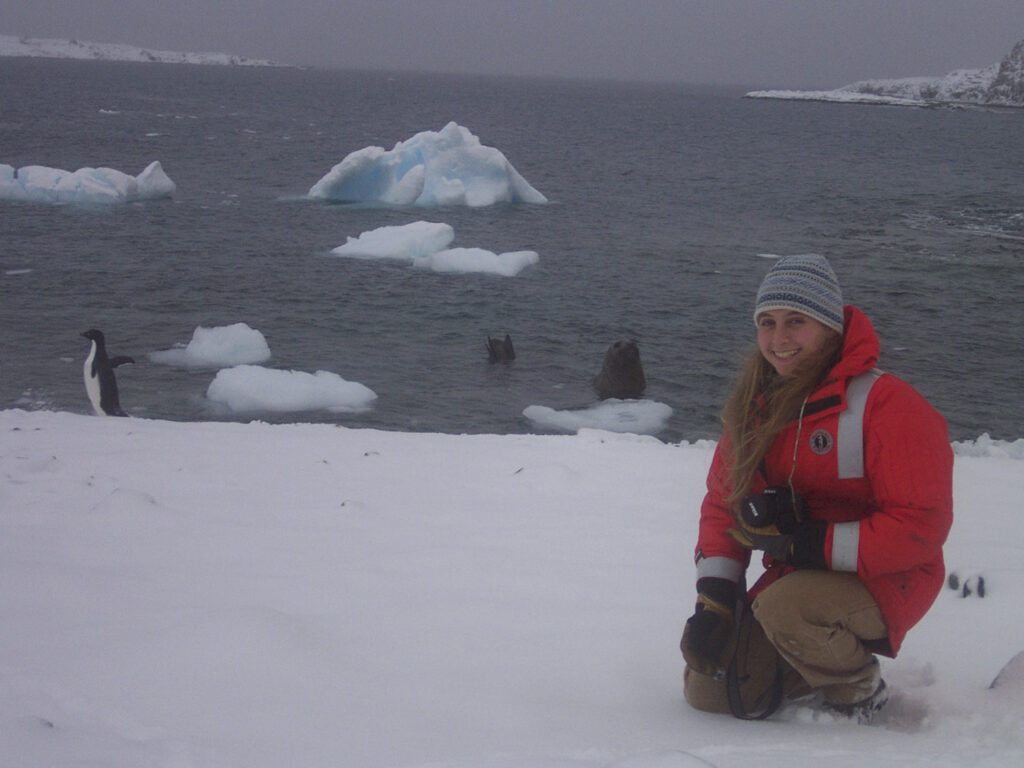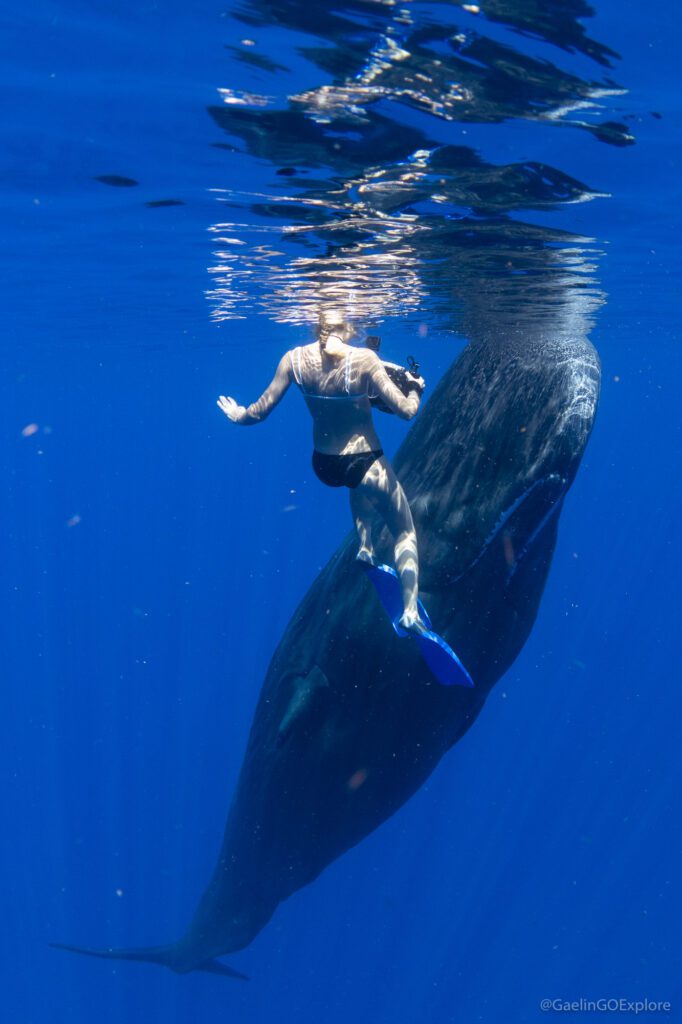Recently we had a chance to sit down with Renaissance woman Gaelin Rosenwaks, to find out more about her upcoming book and film, and her lifelong love of Montauk and the Ocean. Here are our questions, and her answers.

What’s your connection to Montauk?
My mom had been coming since she was a kid and fell in love with it out here. I’ve been coming here my entire life, and now I’m lucky enough to live here.
Your career is so multi-faceted: marine scientist, explorer, photographer, writer, filmmaker – how did that evolve?
It definitely started when I was young, spending time fishing and pulling seine nets. We were always going to the beach, and I was in and around the ocean since I can remember. I actually can’t remember not swimming, and the ocean not being a huge part of my life.
And then in high school, it really started. I spent my time learning everything that I could, and finding any program, or any little science camp — reading books and textbooks on my own…and then obviously college and grad school and a million things from then.
What’s the coolest thing you’ve ever caught in a seine net?
Depends on where, but up here, the coolest thing is probably a seahorse or a pipefish. We used to get a lot of baby blowfish, and baby striped bass; I always loved all of the baby fish.
Are there fewer blowfish now?
Yes there certainly are fewer blowfish now, but I think they’re making a little bit of a comeback. We’re seeing them more.
What’s your biggest concern about the state of the oceans right now?
There are quite a few areas of concern, unfortunately. There are more areas of concern than areas to be optimistic about. But I am an optimist. One of the big problems facing our ocean is plastic pollution, and the overuse of single-use plastics. They are a necessary evil in many parts of our lives, for example, in hospitals. But for many things, there are alternatives, and we’ve certainly seen an upsurge of plastic usage with the pandemic. But I think fortunately more and more attention is being drawn to the problem, and more solutions are in development.
Another challenge is the ocean is acidifying and warming. Certain things are just going to get pushed out or moved north, and it’s unfortunate. Other things will move in from the south. I don’t like to use the words “climate change;” it’s too big. Not that it’s not happening, because it is, but it’s too encompassing, and people don’t all view those two words in the same way. So, I don’t love to use that term because it’s not something that’s tangible. Because things are changing all the time, right? We change seasons, you know, one day my magnolia tree is blooming, the next day it’s covered with leaves, and then obviously in the winter it’s bare. So that’s a change that we’re visibly seeing, but I do think that there are certain tangible parts of our changing climate, of our changing world, that we can actually quantify in an easier way for people to understand, and for people to grasp onto.

Any positive trends that you would like to highlight?
I think especially up here what we’re seeing is improved water quality, which is awesome. We’re seeing more and more menhaden, because they’ve been protected. In turn, now we’re seeing more whales, and more sharks. We’re seeing more seals, also because they are being protected. I think that that’s something to be optimistic about. It shows that we can institute positive change with sometimes drastic, but also smaller, measures of conservation. Using science to manage our oceans.
I think there’s nothing better than seeing whales feeding off our beaches. It’s amazing. When I was a kid, I would never have thought we were going to see that. And certainly in the past, in the history of the East End of Long Island, that was a huge trend. They used to see whales all the time — that’s why it became a whaling area. So that’s definitely positive.
If management and protection can make such a big difference, though, there is hope, right?
Yes, with good science-based management efforts, there should be a lot of hope. And we are seeing that. For example, we’re seeing a positive trend in bluefin tuna. When I did my graduate work on bluefin tuna, bluefin were really precipitously declining at that time. It got to the point where it was really depressing as a graduate student to be studying a fish whose populations were near being listed as endangered, and some were even were toying with this word “extinction” for a bluefin, back not even 20 years ago. And what we’ve seen is, with increased scientific knowledge, and better quotas and better management, and understanding the stock dynamics of these fish, we’ve been able to protect them — so that now we’re seeing more bluefin. In fact, I saw bluefin off of our beach last summer. And that to me was unheard-of. And we’re seeing more and more. The important thing is, once we see those increasing numbers, to keep that management in place. So that these populations can continue to grow. The beautiful thing with fish is that in general, bony fish, they broadcast-spawn. So, two fish can have the potential to create hundreds of thousands of babies. Even when the situation is dire, you really don’t need very many to have this explosion of population and it’s important to keep the population at a certain level for enough time that they can rebound. And then it’s going to be exponential growth, which is so exciting. We don’t see that with whales and sharks as much, because they all have single babies. Well, whales mostly have single babies and certainly sharks will have anywhere from one to a dozen, so it’s not very many.
Are sharks good parents?
Sharks do not take care of their young like mammals. There are sharks that lay eggs, so they’ll just lay their eggs somewhere and leave them, or they do have live birth, but again, once the baby is born, they swim off on their own. I don’t think anyone’s ever seen a little school of sharks taking care of each other. I’m pretty sure that if the babies don’t get away that the shark may go and eat them. But whales…whales are mammals, so they’re smart and they have huge brains, and they nurse their young. So inherently they have to take care of them. And I think that’s why we can connect with them in such a beautiful way. Because they were land animals that moved back into the ocean. They’re pretty phenomenal creatures.
What can we do as individuals to reduce the negative impact that people have on the ocean?
One is to use less single-use plastic, and to make sure that you dispose of everything properly, so it doesn’t end up going straight into the ocean. And to make efforts to lower our individual footprint on the planet. To use less is a big thing and to be a conscious consumer. To know where your fish come from, if you’re eating fish. We’re very fortunate out in Montauk that there’s a lot of great seafood so it makes it easier. Shellfish farming is one of those really great industries, too, because it cleans water and provides food at the same time. One easy thing to do is to never get a helium balloon; I find at least one floating almost every time I am out on the water.
You’ve dived, swum, fished, traveled all over the world. If you had one place to go back to, to explore, what would it be?
That’s a tough question. I’m always happy when I come home to Montauk, to be honest with you. If I had to choose one place, I would like to go back to Antarctica, because I started my career working there, and I would love to see how it has changed. When I was there, very few people were around and it was amazing. The tourist industry has ramped up and I would love to see that impact. But also just to go back, because it’s a very special, incredible place.

Do you have any travels planned for this year?
My big expedition is finishing my film, having just finished my book. Most of the field work for the book and film has been completed, and we’re in what I’m calling a “post-production expedition.”
Which would you like to talk about first, book or film?
They’re very much linked, as the stories build off of each other. They are both about sperm whales.
FINDING PHYSTY is a documentary about my personal connection with sperm whales. When I was a toddler, a young sperm whale, Physty, stranded off the beach near Robert Moses State Park here on Long Island. I was lucky enough to visit him while in captivity before he was rehabilitated and released back into the wild. Physty made a huge impression on me, and the film follows my journey to answer the questions: where should Physty have been when he stranded, back when he was a six-year-old sperm whale? And where would he be now, 40+ years later, providing that he survived that ordeal? Could we find Physty? In the process of asking these questions, the film explores the dynamics of sperm whale families.
The expeditions for the film took me to Dominica where I was able, under strict government permits, to get into the water with the sperm whales so that I could start to understand their family dynamics. While shooting the film, I was also making photographs to document the sperm whale families of Dominica. The book takes a deep dive into the dynamics of sperm whale families and their strong matrilineal bond. With the females staying togeher for their entire lives and the males leaving their families when they reach adolescence.
How old is a whale adolescent?
It’s thought that the females reach sexual maturity earlier than the males, and start breeding in their early teens. And then the males reach adolescence in their teens, so probably around 12 years old, and they won’t start breeding till they’re in their 20s.
What do they do to impress females?
They have this clanging noise that they make, that sounds like metal things clanging against each other. That’s one of the ways they attract the females. But they’re so elusive and they spend most of their time at depth, they’re hunting in thousands of feet of water. They’re one of the greatest free divers on the planet. They stay down for close to an hour at a time. They’re incredible animals physiologically. We’re seeing just a glimpse of their lives on the surface.
Sperm whales are very vocal. They talk to each other with codas, and they have culture. They’re incredible animals, very similar to humans and elephants. Whales came out of the sea and then went back to the sea. They’re air-breathing, it makes no sense — they have to come up to the surface to breathe. They have lungs, and it’s pretty cool.
What’s their average lifespan?
They definitely live over 70 years, so it’s a very similar lifespan to humans, probably longer. A lot of the data on sperm whales comes from the whaling industry, because they kept careful notes on everything, so I think that the oldest one recorded was 84, or something like that. Certainly, well into their 80s. And they used to get huge.
Your book is also about sperm whales.
I have a photography book coming out in the Fall about sperm whale families entitles, SPERM WHALES: GENTLE GOLIATHS OF THE OCEAN, which will be published by Rizzoli Publications. I started with the film and as I was creating the film, and going down to Domincia to film and photograph the whales, I built a large body of photographic work that I am excited to share in this volume. Sperm whales are matrilineal, the mothers and daughters stay together for their entire lives. I photographed the families — mother, babies, aunts and grandmothers — along with some incredible unique behaviors, capturing the tender moments between mother and child, and aunt and niece. The book tells the tales of these sperm whale families through my photographs.
The book will come out in October, but it’s now available for pre-order. All of the photography is my photography and it’s my writing, and then Carl Safina wrote the foreword.

How experienced should you be before you attempt to swim with whales, or sharks, or similar?
I get these questions a lot, and I think you should be very comfortable in the water. I also am not a big fan of the tourist industry around swimming with whales. I have a scientific permit to get in the water and I’m super-careful when I’m in the water with them. You’re in thousands of feet of water when swimming with sperm whales. You’re not in shallow water. If you go to swim with humpbacks in Tahiti or Tonga, you’re on a reef, so it’s shallow water. But you’re still next to a very big animal. And there’s a certain comfort that’s really important. I can’t imagine getting in the water with them if I wasn’t so comfortable. Same with sharks. Sharks I think scare people a lot more. You need to be a really strong swimmer, but I think that any time you’re in the water you should be a strong swimmer.
To what extent did your mother have an effect on your career?
I would say, a lot! She’s the one who took me to see Physty, and as a kid, she’s the one who introduced me to the ocean. She took my brother and me to the beach all the time, because she loved it. She loves the ocean, so I think she has that passion that she shared with me, and then I just took it that next step, to make it my career.
It either speaks to you or it doesn’t, and for me the ocean is my whole life. I spend a week away from the ocean, and it’s time to go back.
It’s easy to talk about the glamorous side of my job, but it has been an extremely difficult journey, with a lot of sacrifice. I get this question a lot from kids — “how did you do it?” and I couldn’t even tell you. And for most people, if they really knew what it took, they would never choose to do it, but for me, it has all been more than worth it!
**********
Gaelin will be speaking at the Oceans Institute of the Montauk Point Lighthouse later this summer. Please check our events calendar for dates and times.
You can preorder her book here: https://www.rizzoliusa.com/book/9780847872329/
You can watch the trailer of her film, FINDING PHYSTY, here: http://www.gaelinrosenwaks.com/findingphysty
All photos courtesy of Gaelin Rosenwaks. To keep in touch with what she’s doing, see: http://www.instagram.com/gaelingoexplore
